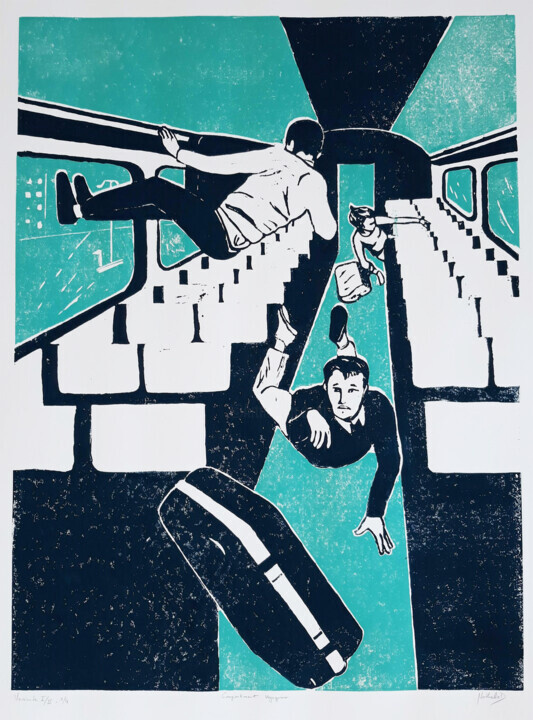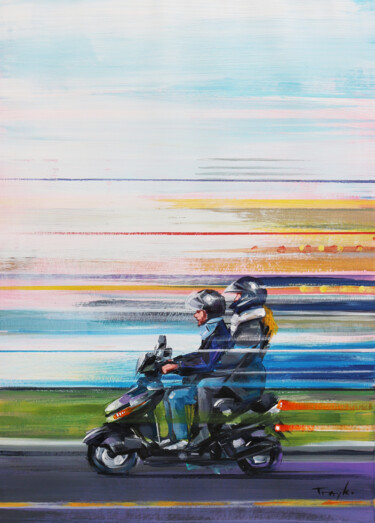 WORLD TRAVELER. VALERY (2022)Painting by Bruno Mellis.
WORLD TRAVELER. VALERY (2022)Painting by Bruno Mellis.
Happy vacations!
We are at the beginning of August and the cities are finally emptying out, people are saying their goodbyes and postponing their talk until September, when the urban concrete will cease to bubble as theasphalt, allowing everything to continue that has been interrupted by the arrival of the impending, much-needed and much-desired vacations. During our sojourns abroad, or in any holiday resort more or less close by, we will think, while relaxing a bit, about what we have momentarily left behind in our place of belonging, especially if the arrival of the vacation has interrupted the development of some situation, which was particularly close to our heart, freezing it in a hypothetical, prosperous and hopeful future. ..Behold! This is the way in which travel is generally perceived by us poor ordinary mortals, which makes me wonder, at this point, how, on the other hand, it was experienced by the greatest "gods" in the history of art, a question that I can answer with three possible variants, which I will illustrate through the construction of a figurative narrative. In fact, the artists, who used to move around to study painting, coming into contact with other masters, movements or currents, cultural realities and landscapes, could follow a very specific itinerary, such as the imposed one of the Grand Tour, or move freely, concentrating on capturing, both other travelers and the places that were the object of their transfers.
 COMPARTIMENT VOYAGEURS (2020)Printmaking by Nathalied.
COMPARTIMENT VOYAGEURS (2020)Printmaking by Nathalied.
 " VOYAGE " (2020)Photography by Emmanuel Passeleu.
" VOYAGE " (2020)Photography by Emmanuel Passeleu.
The concept of the Grant Tour appears pictorially explicated by Emil Brack's masterpiece titled, precisely, Planning the Grand Tour, within which two figures, in accordance with tradition, do their best to study a map of Italy in order to plan their cultural journey to the most popular destinations of Rome, Venice, Naples and Florence. It was precisely the latter destinations that were the most popular for this type of travel, which, widespread from the 18th century onward, was designed to perfect knowledge as well as artistic skills, directing attention to the great centers of classical, Renaissance and Baroque architecture, sculpture and painting, to also visit some of the few institutions on the Grand Tour circuit such as that of the Uffizi Gallery, inaugurated in 1765, and the Vatican Museums, dated 1769-1774. It is possible to place side by side with this more traditional and historical type of travel, to travel dictated by practical necessity, as well as purely personal interests, just as the artistic investigation of Augustus Leopold Egg, a Victorian-era British artist who, seeking relief from asthma, frequently visited the south of England and France, capturing the iconic image depicted by one of his best-known masterpieces, namely The Travelling Companions (1862), a painting aimed at depicting two elegant women, who, seated facing each other inside a first-class carriage, take on the appearance of a mirror vision. The symmetry of the effigies is reflected in the features of the carriage, although these similarities cease to exist through the careful observation of certain details, such as, for example, the fact that one woman is intent on reading, while the other is lost in sleep. Still on the subject of travel by train, it is impossible not to think of Honoré Daumier's The Third-Class Carriage, in which the theme of travel becomes functional to another kind of narrative, which, purely concerned with social issues, paints the lives of workers in the emerging industrial metropolises. It is precisely this context, which is not celebrated in its technological innovations but exalted in the hardship of the less affluent travelers, that expresses a point of view sharply at odds with the predominant images of the time, generally aimed at promoting the nascent and modern means of transportation as a symbol of beneficial progress. At this point it is good to highlight how artists, however, not only moved to capture other travelers, but also to tell us about their destination places, allowing us to move without a ticket, through a figurative narrative made up of a succession of brushstrokes, which, in the case of Vincent van Gogh's View of Arles, Flowering Orchards (1889), concur to describe the view of the French city of the same name caught by a canal, whose bank, full of poplars, overlooks the city center, of which we can glimpse the towers of St. Trophime, the College of St. Charles and the Calvin Barracks. To visit Toledo, however, we can refer to the work by El Greco entitled View of Toledo (1596-1600), depicting a landscape with rather dark and vibrant blue, black, white and green tones, in which the most evident contrast is realized between the bright flashes of the sky and the seriousness of the earth, aimed at telling the moods of the city, in which the painter lived and worked for most of his life, describing it in an emblematic rather than documentary way. Finally, we will leave the task to Monet's English travels to describe one of the most famous attractions of the city of London, namely the Parliament, expertly captured by the homonymous series of works executed between the autumn of 1899 and the first months of 1900 and 1901, in which the Palace of Westminster, captured from the point of view of Monet's window or from a terrace of St Thomas' Hospital, is often captured immersed in fog with a profile that is barely intuitable. After these great masters of art history, the "painting on the go" story continues through the analysis of some works created by the artists of Artmajeur, namely those of Pavel Korzukhin, Svetlana Lebedeva and Natalia Shchipakina.
Travel amulet by Pavel Korzukhin
If the paintings of most artistic movements and currents have had us travel by taking advantage of the most common means of transportation in order to reach real, or at least easily accessible, destinations, it is the task of Surrealism to abandon this approach to departures, to take us, as in the case of Travel amulet, into the little-explored upper layers of the atmosphere, moving on an unconventional boat-mongol in the shape of a seashell. The latter protective casing, generally trapped in the sand of the sea, has finally been able to shed its weight, as well as its terrestrial habitat, coming to disassociate itself from all forms of standardization attached to it, to take part in pictorial narrative of a dreamlike character, in which a boat uselessly retains one of its oars. As a matter of fact, the latter is now led, rather than by sea currents, by a light and imperceptible breeze, which allows the shell to observe from above downwards a crescent moon, aimed at taking the shape of a smile, perhaps stimulated by that feeling of freedom ascribable to the world of dreams and imagination, which is well manifested in Surrealism. Referring instead to the words of Pavel Korzukhin, the work makes manifest a lyrical composition, having the purpose of giving form to the theme of marine wanderings, aimed, as is usual for the painter's art, at externalizing the paradoxes of modern life, explicating them through the aesthetic and technical forms of a painting, in which the total stylistic eclecticism and the mutually exclusive mixture of images are corrected by the author's harmonious vision.
 TRAVEL (2020)Painting by Svetlana Lebedeva.
TRAVEL (2020)Painting by Svetlana Lebedeva.
Travel by Svetlana Lebedeva
What makes Lebedeva's painting innovative? The way in which an airplane is captured, a subject that was probably observed by the artist, at the moment when she herself was perhaps sitting inside it, where, from the window, she was able to study its wing, which was caught in the moment of takeoff, during which the plane takes a run-up to hover in the sky vertically, before assuming a horizontally position. Likewise, however, it cannot be ruled out that the areoplane in question is almost about to land, allowing us a glimpse of the earth's surface, soon to be trodden by our feet again. Within the narrative of art history, however, noteworthy is the existence of a pictorial movement, which made the airplane's ability to fly its greatest source of inspiration: I am talking about "Aeropittura" (Aereo-painting), a declination of Futurism born in the 1910s and established itself after World War I, a time when inspiration was drawn from the myth of the machine and modernity, culminating in the dynamism, flight and speed of the areoplane. What has just been stated can be summed up by the work Dynamism of Train Ship Airplane (1930) by Giulio D'Anna, an Italian painter and publisher born in 1908, who chose "Aeropittura" to satisfy his personal need for escapism and aspiration toward those journeys that he succeeded, alas, only in his imagination, as he never realized that much-dreamed of direct experience of flight, first mentioned within the painting dated 1928 and titled Visual Exhilaration.
 BARCELONA. SPRING (2023)Painting by Natalia Shchipakina.
BARCELONA. SPRING (2023)Painting by Natalia Shchipakina.
Barcelona spring by Natalia Shchipakina
The masterpieces of art history analyzed above have led us, through the action of travel, to learn about the destinations visited by some of the best-known masters of all time, but without making us believe that it was the artist's desire to bring us into contact with a reality different from our own. In fact, in the works mentioned, such as those of Van Gogh, Monet and El Greco, the main purpose was to make us partakers of a message, a vision or new expressive techniques, rather than to lead us faithfully to the discovery of a place, borrowing a realist language, aimed at activating a sterile tourist guide mode. What has just been described, that is, the externalization of a personal and free vision, without merely emulative purposes, is repeated in Shchpakina's post-Impressionist depiction of Barcelona, aimed at describing an entire part of the city by depicting only its symbol, to render the rest through the appearance of a few geometric figures, which appear here and there with the task of giving life to an indistinct mass of houses. Such an approach is not reserved by the painter only for the Catalan capital, as she captured with kindred stylistic features many of the best-known travel destinations, matching the desire to get to know places far away from us with the dedication to see them as they appear exclusively to the eyes of the artist, who admits to looking to the example Claude Monet, Vincent van Gogh, Isaac Levitan, Auguste Renoir, that is, to masters who had far surpassed the simple reproduction of the real datum, to prefer the rendering of atmosphere, light, interiority and emotions.



 Olimpia Gaia Martinelli
Olimpia Gaia Martinelli











